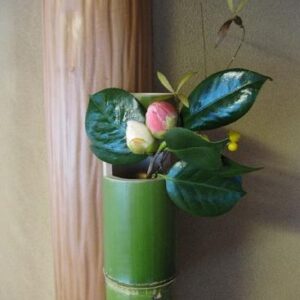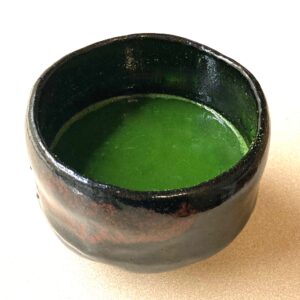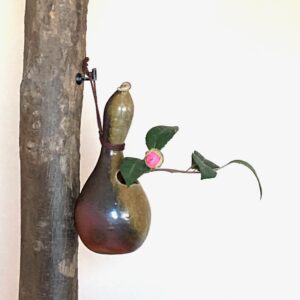Tea Mirroring Flowers
There are strong associations between a bowl of tea and a flower in a vase.
Cha, 茶, tea
Yu, 湯, hot water
Cha-wan, 茶碗, tea-bowl
Hana, 花, flower
Mizu, 水, water
Hana-ire, 花入, flower-receptacle



Left: green bamboo hana–ire, 花入, flower-receptacle, containing a tsubaki, 椿, camellia. Center: ceramic cha-wan, 茶碗, tea-bowl, containing ma-tcha, 抹茶, powder-tea. Right: ceramic hanaire with tsubaki.
Hana-ire, 花入, flower-receptacle, ao-dake, 青竹, green-bamboo, with side opening, ichi-jū-giri, 一重切, one-tier-cut. Sen no Rikyū is credited with being the first person to display a green bamboo hanaire in the tokonoma for a Tea gathering. Green bamboo is often associated with memorials. The bamboo was cut from the living plant, and modified by cutting it to measure, putting an opening in the side, and removing the inner fushi, 節, nodes, except for the fushi at the base of the vase.
The chawan is kuro-Raku, 黒楽, black (glazed)-Pleasure, diam. 4 sun kane-jaku, made by Sa-sa-ki Shō-raku, 佐々木松楽, Help-assist-tree Pine-pleasure, founded in 1935. The name Shō-raku, 松楽, with Kanji for ‘pine’, is a branch of Sa-sa-ki Shō-raku, 佐々木昭楽, Help-assist-tree Bright-pleasure. The kiln is located in Kame-oka, 亀岡, Turtle-hill. There are chawan made of bamboo, that are often lacquered. Green bamboo teabowls may exist. And there are many green bamboo sake cups.
The green bamboo hanaire is most appreciated as a flower vase at a Cha-ji, 茶事, Tea-matter. The more familiar hanaire is most often made of ceramic, and other hanaire are made of aged bamboo, metal, glass, and baskets. The picture of the gourd flower container is a stoneware hyō-tan, 瓢箪, gourd-basket, with ash glaze, Bi-zen yaki, 備前焼, Provision-fore fired, by Yama-moto Sō-shū, 山本宗秀, Mountain-origin Sect-excel; H. 7 sun kane-jaku. The opening in the side of the vase is a highly stylized gourd. The hanaire is hanging on a blackened steel hana-ori-kugi, 花折釘, flower-fold-hook, driven into the toko-bashira, 床柱, floor-post. The post is made of katsura, 桂, cinnamon bark-tree. The post grew in front of my former apartment building. It was taken down for fear its height would damage nearby windows in high winds. The double bottle gourd is a sacred emblem in Taoism, and represents good health and plenty.
The tea plant, cha, 茶, is related to the camellia, tsubaki, 椿. Tea’s Latin name is camellia sinensis, Chinese camellia. Flowers and a hanging scroll are usually displayed in the tokonoma for a Tea gathering. Tea is prepared in the presence of the guest. The flower is relatively alive, simply cut from a plant, and put into water in a vase, is sprinkled with tsuyu, 露, dew. The flower is a thing from nature, is wet, and like all ‘things’ is an aspect In, 陰, negative, receptive. The tea to be drunk is first picked, processed, dried, rolled, stored, and ground to a powder that is dry, which is an aspect of Yō, 陽, positive, penetrative. The flower is directly from nature, the tea is manufactured. When the tea is mixed with water, it becomes an aspect of In, 陰, negative and receptive. The flower is cut and kept temporarily kept alive in water. After the Tea, the flower is discarded, returned to nature. The tea is drunk; its physical substance goes to the stomach, which is identified as negative, In, 陰, whereas the tea’s limbic essence goes to the brain to alter thinking, which is identified as positive, Yō, 陽, penetrative. In belly and Yō brain.
The flower drinks the water – the water is naturally cold. The guest drinks the tea – the water is made hot.
Water is often obscured within the hanaire. However, for hanaire with open mouths, the water can be seen filled to the rim at first, and after the Tea, the water has been drunk by the flower, and the water level has lowered, showing the passage of time. No time for Tea. Water becomes obscured when mixed with the tea powder. Clear water has a physical nature, but is transparent and invisible. Tangible space. Water mixed with tea is substantial, but visible in the guise of powdered tea. Matcha is a suspension, whereas steeped tea is transparent and may have color. In time, a bowl of tea offered to spirit, the tea particles will settle to the bottom of the bowl, and the water above becomes clear.
The flower in water in a vase is displayed in the Tearoom prior to the arrival of the guests. In some instances, one or more hanaire filled with water are displayed in the Tearoom, together with a tray of fresh flowers, a knife, and a small pitcher of water. The host invites the guests to arrange flowers in the various hanaire. At times, the guest adds a few drops of water to the container, which is usually done by the host.
The preparation of a bowl of tea happens in the presence of the guest, which is called ten-mae, 點前, offer-fore, presentation. The utensils used to prepare the bowl of tea, are carefully chosen for the presentation in the presence of the guests.
The tea and the flower are relatively alive, and temporary for the present.
Water is the nourishment of life, and for the future.
The chawan and the hanaire are relatively permanent, and from the past.

